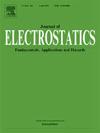用于工业应用的摩擦充电粉末滴的结垢
IF 2.1
4区 工程技术
Q3 ENGINEERING, ELECTRICAL & ELECTRONIC
引用次数: 0
摘要
颗粒材料的摩擦起电是一种鲜为人知的现象,它改变了颗粒的行为,影响了诸如散装粉末处理和输送等工业过程。在小尺度下(2克),粉末的净电荷已被证明与总颗粒表面积线性变化,因此对于给定的尺寸分布质量。这项工作研究了颗粒摩擦电荷的结垢关系,使用定制的粉末跌落装置和法拉第杯测量对工业相关材料进行了小、中(2-200 g)和大(~ 400 kg)的实验室测试。我们的研究结果表明,在达到工业相关规模之前,这种规模被打破了。电荷(Q)随质量(m)的标度拟合为Q∝mb的函数,其指数范围为0.68±0.01 ~ 0.86±0.02。这些指数介于散装粉末的表面积(b=2/3)和总颗粒表面积(b=1)之间。这种缩放关系被发现在测试的粉末中保持不变,并且在不同的湿度下保持稳健,尽管绝对电荷大小发生了变化。本文章由计算机程序翻译,如有差异,请以英文原文为准。

The scaling of triboelectric charging powder drops for industrial applications
Triboelectrification of granular materials is a poorly understood phenomenon that alters particle behaviour, impacting industrial processes such as bulk powder handling and conveying. At small scales (2 g) net charging of powders has been shown to vary linearly with the total particle surface area and hence mass for a given size distribution. This work investigates the scaling relation of granular triboelectric charging, with small, medium (2–200 g), and large-scale (400 kg) laboratory testing of industrially relevant materials using a custom powder dropping apparatus and Faraday cup measurements. Our results demonstrate that this scaling is broken before industrially relevant scales are reached. Charge (Q) scaling with mass (m) was fitted with a function of the form and exponents ranging from to were determined. These exponents lie between those that would be expected from the surface area of the bulk powder () and the total particle surface area (). This scaling relation is found to hold across the powders tested and remains robust under varying humidity, despite changes in the absolute charge magnitude.
求助全文
通过发布文献求助,成功后即可免费获取论文全文。
去求助
来源期刊

Journal of Electrostatics
工程技术-工程:电子与电气
CiteScore
4.00
自引率
11.10%
发文量
81
审稿时长
49 days
期刊介绍:
The Journal of Electrostatics is the leading forum for publishing research findings that advance knowledge in the field of electrostatics. We invite submissions in the following areas:
Electrostatic charge separation processes.
Electrostatic manipulation of particles, droplets, and biological cells.
Electrostatically driven or controlled fluid flow.
Electrostatics in the gas phase.
 求助内容:
求助内容: 应助结果提醒方式:
应助结果提醒方式:


